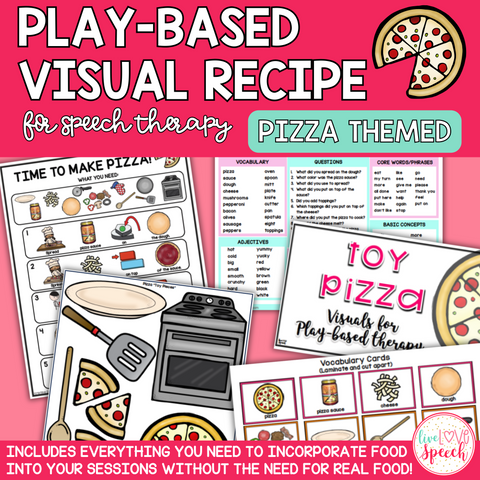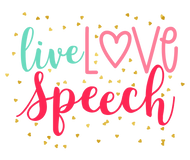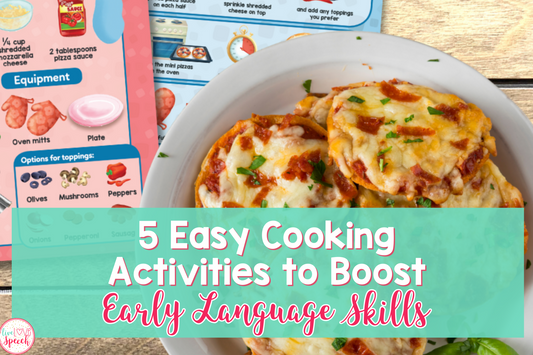
Don't we all want our kids to have fun while learning? What if I told you they can learn and play all at the same time? Instead of battling with them to focus, how about we put some "play" in front of them and get to learning? This is where play-based learning comes into view. As a Speech-Language Pathologist (SLP) with a passion for food and communication, I am pumped to introduce my new Play-Based Visual Recipe Resources designed to help your kids with speech and language development.
What are Play-Based Visual Recipes:
Play-Based Visual Recipes are unique resources tailored to engage children into the exciting world of cooking. And guess what? They can do this by using their favorite toy foods such as pizza, tacos, and more. Don't worry if you don't have toy foods I provide interactive printable pieces. For instance, my Play-Based Taco-Themed Visual Recipe, I have each piece you (your child) will need to build a delicious taco, just like that do it at home.
Again, this isn't just a normal visual recipe; each visual recipe includes step-by-step instructions presented in a playful, easy-to-follow format. That way, your kids don't get frustrated and can enjoy what they are doing. Plus, by incorporating some of their favorite toys, they can learn and start on some cooking fun right in their playroom, all while fostering creativity and communication. This is a great way to implement play-based learning!
Benefits for Speech and Language Development:
Cooking, even in a pretend setting, offers a wealth of benefits for language development:
1. Vocabulary Expansion: My visual recipes introduce new cooking terms and ingredient names, enriching children's vocabulary. Plus, you can add in some core words such as "mix," "pour," "stir," and "slice," which are essential for both cooking and everyday communication.
2. Sequencing Skills: Following recipe steps helps children understand the concept of sequencing, a crucial skill for organizing thoughts and storytelling. It makes it easier for them to understand and use words like "first," "next," "last," etc.
3. Following Directions: Practicing recipe instructions reinforces listening skills and the ability to follow multi-step directions. What kid doesn't want to play? They're definitely going to be listening, trust me—Landon always listens when it comes to playing something.
4. Social Interaction: Cooking is often a communal activity. Through play cooking, children learn to communicate and collaborate with peers, enhancing social skills.
5. Problem-Solving: When things don't go as planned (even in pretend play), children learn to adapt and problem-solve, encouraging flexible thinking and resilience.

How to Use the Play-Based Visual Recipes:
Whether you're a parent, teacher, or fellow SLP, these resources are adaptable and easy to integrate into various settings. Let me give you an example of where you can use them using my Play-Based Pizza-Themed Visual Recipe as an example.
1. Home: Encourage imaginative play at home by setting up a "toy kitchen" area with the visual recipe cards. You can create a cozy cooking corner where kids can explore their creativity. For example, gather toy pots, pans, and utensils, and set them up alongside the visual recipe for a pizza-themed adventure. You can even extend the play by encouraging children to create their own variations of the recipe using their imagination.
2. Classroom: Incorporate these recipes into lessons on sequencing, descriptive language, or social skills during playtime. You could organize a cooking-themed day where students work together to follow the steps of a visual recipe, like making pizza. Each step provides an opportunity for discussion and practice of vocabulary related to cooking, such as "knead," "spread," and "toppings." Additionally, students can take turns role-playing as chefs and customers, promoting social interaction and cooperation.
3. Therapy Sessions: Use the recipes as therapeutic tools to target specific speech and language goals in a fun, engaging manner. For instance, if a child is working on articulation, you can focus on words related to the recipe, such as "cheese," "sauce," and "crust." Incorporate these words into activities like describing the ingredients or retelling the recipe steps. Furthermore, you can tailor the difficulty level of the recipe tasks to match the child's language abilities, providing opportunities for growth and success.
By integrating play-based visual recipes like the Pizza-Themed Visual Recipe, you can spark excitement and creativity while supporting speech and language development in a variety of settings.
Toy Tacos, Toy Pizzas, and MORE!
My initial set of resources features beloved toy foods like tacos, pizzas, ice cream, cookies, and sandwiches. Each recipe is designed to engage young minds and encourage interactive learning through play hence the word play-based learning. Keep an eye out as I expand my collection! But for now, enjoy everything from scrumptious sandwiches and delightful cookies to mouthwatering ice cream treats, there's something for everyone—whether it's a sweet treat or a playtime dinner.
What's Included:

Each of these resources are designed to enrich play-based therapy sessions and enhance communication skills. Each component is crafted to engage and support children in their language development journey.
Guides and Visual Aids: From practical guides to interactive activities, this package offers a variety of tools to facilitate effective therapy sessions. The Play-Based Therapy Information & Tips for Communication guide provides valuable insights and strategies for therapists.
Step-by-Step Directions and Comprehension Questions: The Visual Recipe with Step-by-Step Directions introduces a fun cooking activity to promote language and sequencing skills. Comprehension Questions with Visual Answer Choices facilitate understanding through interactive questioning.
Vocabulary Cards: Vocabulary Cards expand language skills, while the Play-Based Therapy Cheat Sheet serves as a handy reference for therapists.
Interactive Play Materials: The package includes Interactive Toy Pieces in both color and black & white, encouraging hands-on play and creativity. The Visuals for Toys Booklet features a range of visuals, from vocabulary words to numbers and shapes, to support language learning.
In addition to these materials, a page of Core Words & Phrases targets essential communication skills. A Parent/Guardian Letter informs families about the goals and benefits of play-based therapy, fostering collaboration. The Cut & Paste Sequencing Activity reinforces sequencing skills.
With this comprehensive set of resources, therapy becomes not only effective but also enjoyable and engaging for children.
Get Started Today:



Cooking isn't just about making meals—it's a powerful tool for fostering communication and cognitive growth in children. With my Play-Based Visual Recipe Resources, let's empower our kiddos to savor the joys of cooking while building a strong foundation for speech and language development.
Are you ready to cook up some communication?
Let's explore, play, and learn together!
SAVE THIS POST
Don't forget to save this post on your favorite Pinterest board so you'll be all set when it comes time to plan your next Speech & Language activity!







1 comment
We commend the insightful article on how play-based visual recipes foster speech and language development. The approach outlined is both innovative and pedagogically sound.